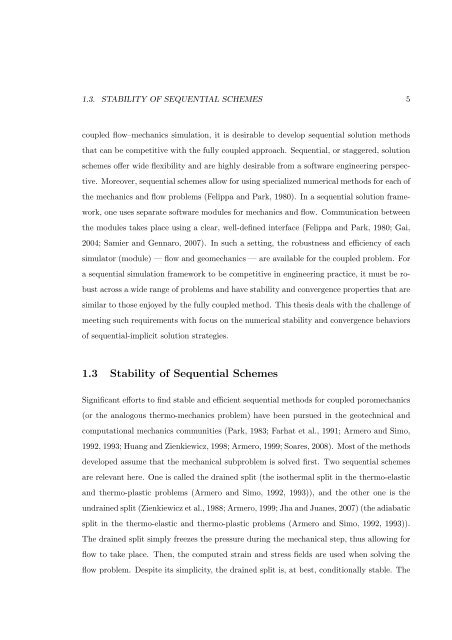Sequential Methods for Coupled Geomechanics and Multiphase Flow
Sequential Methods for Coupled Geomechanics and Multiphase Flow
Sequential Methods for Coupled Geomechanics and Multiphase Flow
Create successful ePaper yourself
Turn your PDF publications into a flip-book with our unique Google optimized e-Paper software.
1.3. STABILITY OF SEQUENTIAL SCHEMES 5<br />
coupled flow–mechanics simulation, it is desirable to develop sequential solution methods<br />
that can be competitive with the fully coupled approach. <strong>Sequential</strong>, or staggered, solution<br />
schemes offer wide flexibility <strong>and</strong> are highly desirable from a software engineering perspec-<br />
tive. Moreover, sequential schemes allow <strong>for</strong> using specialized numerical methods <strong>for</strong> each of<br />
the mechanics <strong>and</strong> flow problems (Felippa <strong>and</strong> Park, 1980). In a sequential solution frame-<br />
work, one uses separate software modules <strong>for</strong> mechanics <strong>and</strong> flow. Communication between<br />
the modules takes place using a clear, well-defined interface (Felippa <strong>and</strong> Park, 1980; Gai,<br />
2004; Samier <strong>and</strong> Gennaro, 2007). In such a setting, the robustness <strong>and</strong> efficiency of each<br />
simulator (module) — flow <strong>and</strong> geomechanics — are available <strong>for</strong> the coupled problem. For<br />
a sequential simulation framework to be competitive in engineering practice, it must be ro-<br />
bust across a wide range of problems <strong>and</strong> have stability <strong>and</strong> convergence properties that are<br />
similar to those enjoyed by the fully coupled method. This thesis deals with the challenge of<br />
meeting such requirements with focus on the numerical stability <strong>and</strong> convergence behaviors<br />
of sequential-implicit solution strategies.<br />
1.3 Stability of <strong>Sequential</strong> Schemes<br />
Significant ef<strong>for</strong>ts to find stable <strong>and</strong> efficient sequential methods <strong>for</strong> coupled poromechanics<br />
(or the analogous thermo-mechanics problem) have been pursued in the geotechnical <strong>and</strong><br />
computational mechanics communities (Park, 1983; Farhat et al., 1991; Armero <strong>and</strong> Simo,<br />
1992, 1993; Huang <strong>and</strong> Zienkiewicz, 1998; Armero, 1999; Soares, 2008). Most of the methods<br />
developed assume that the mechanical subproblem is solved first. Two sequential schemes<br />
are relevant here. One is called the drained split (the isothermal split in the thermo-elastic<br />
<strong>and</strong> thermo-plastic problems (Armero <strong>and</strong> Simo, 1992, 1993)), <strong>and</strong> the other one is the<br />
undrained split (Zienkiewicz et al., 1988; Armero, 1999; Jha <strong>and</strong> Juanes, 2007) (the adiabatic<br />
split in the thermo-elastic <strong>and</strong> thermo-plastic problems (Armero <strong>and</strong> Simo, 1992, 1993)).<br />
The drained split simply freezes the pressure during the mechanical step, thus allowing <strong>for</strong><br />
flow to take place. Then, the computed strain <strong>and</strong> stress fields are used when solving the<br />
flow problem. Despite its simplicity, the drained split is, at best, conditionally stable. The
















